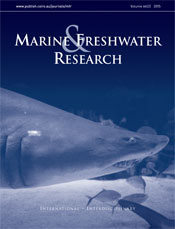Marine and Freshwater Research
Volume 66
Number 2 2015
Estuaries are complex and dynamic ecosystems, so summarizing their health by a single value raises questions about variability, interpretation, sensitivity and confidence. We improved the inferential value of a specific estuarine health index by quantifying two different sources of variation in its construction, enabling us to produce an overall health score and a measure of its uncertainty. This index is subsequently more informative and supports more defensible decisions about management and amelioration of an estuary’s health and function.
Surf-zone fish assemblage was investigated to assess its patterns of variability for two sandy beaches in southern Brazil, using two different beach seine nets and a GLM approach. Species richness seems to be strongly related to season, although the choice of net used can play an important role. The results achieved in this study can be used to assess the most important variables that explain fish behaviour in the surf zone environment.
Dense tropical rainforest streams that include waterfalls and fast flowing shallow water can be difficult for aquatic ecologists to access and survey with standard equipment. Aquatic ecologists compared the detection of fauna within a rainforest stream by snorkelling and deploying baited cameras, demonstrating that snorkelling detects more species during both the wet and dry seasons. This pioneering but preliminary research demonstrates that snorkelling surveys are favourable in safe but difficult to access rainforest environments and illustrates the potential for using cameras in dangerous conditions such as where crocodiles or extreme flow preclude direct human access.
Macquarie perch are an endangered, native Australian species that is threatened by introduced pest fish species such as redfin. We exposed naive Macquarie perch of different sizes to redfin and compared their responses to those exhibited to native predators. We found that Macquarie perch responded appropriately to the threat posed by redfin suggesting that they are able to generalise from native to introduced predators.
In 2006 the third Danish ‘Galathea’ Expedition (the earlier expeditions were in 1845/47 and 1950/52) detected puzzling water property variations across the Great Australian Bight. Satellite temperature images linked the variations to alternating north–south jets connected to large mushroom-shaped features that mixed waters from the continental shelf and open ocean. The Bight is frequented by tuna, whales and other creatures and is being explored for oil and gas.
There are still large gaps of knowledge about the long-distance oceanic spawning migrations of the European silver eel, Anguilla anguilla. By using pop-up satellite tags, the present study is the first to provide datasets on individual behaviour of European eels released in the open Atlantic Ocean and close to their presumed spawning area of up to three months, including detailed information on diel vertical movements. The study is a further step towards a better understanding of the fascinating reproductive biology of eels.
Movements of sand tiger sharks, one of the most vulnerable species of sharks, were tracked along the US East Coast using satellite transmitters. Goals were to identify migratory routes, essential habitat and environmental preferences. Findings reveal timing and location of seasonal migrations, areas used heavily by sharks and application of current area closures for management of sand tiger populations.
In freshwater system, it is unclear how the covariance between structure complexity and turbidity could drive predation and prey selectivity. Here, we evaluate this relationship and suggest that the influence of structural complexity and turbidity on predation may not co-vary under natural environmental conditions; and that small changes in the turbidity level are not sufficient to significantly reduce the number of prey consumed. In contrast, if extreme values are compared, there is a tendency for predation to decrease.
Water quality information in aquatic ecosystems is crucial for setting up resource management guidelines. This study explored water quality and pollution in Lake Naivasha, Kenya. Four components explained 94.2% of the water quality variability based on Principal component analysis. Agricultural and domestic pollution pose the main threat to the lake. Formulation of effective management strategies is emphasized to safeguard ecosystem services and secure riparian communities’ livelihoods in this important lake.
Galaxiella nigrostriata is a freshwater fish that is endemic to the seasonally dry coastal wetlands of south-west Western Australia and considered near threatened. Genetic results showed that all populations were genetically divergent and with some populations morphologically distinct. Taxonomic consideration may eventually lead to several new species being identified, each requiring management and protective strategies to ensure maintenance of this biodiversity.




